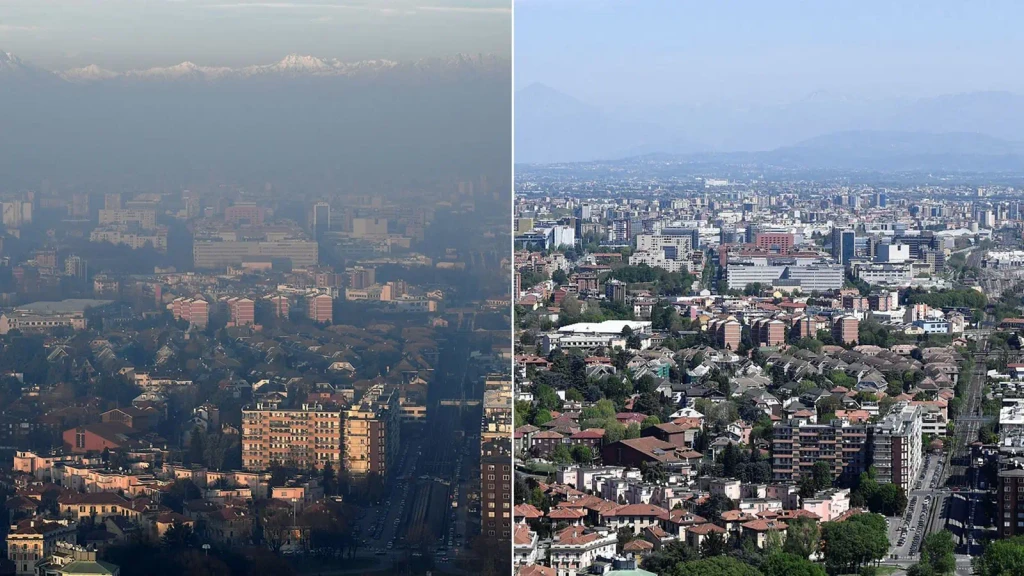Introduction
The COVID-19 pandemic, caused by the SARS-CoV-2 virus, dramatically affected global life in countless ways. Beyond its significant toll on human health, the pandemic brought about unprecedented social and economic changes due to widespread lockdown measures. These measures, implemented to curb the virus’s spread, led to a temporary transformation in air quality worldwide, including across Europe.
In this article, we will explore how the pandemic influenced air conditions in Europe, highlighting both the short-term benefits and potential long-term implications.
#Air Quality Changes During the Pandemic
#Reduced Industrial and Vehicular Emissions
The lockdown measures significantly reduced industrial activities and vehicular traffic across Europe. Major cities, such as Lisbon, Madrid, and Milan, saw dramatic decreases in nitrogen dioxide (NO2) levels. NO2, primarily emitted from vehicles and industrial processes, is a key pollutant linked to respiratory illnesses and environmental damage.
Satellite data from the European Space Agency revealed that NO2 concentrations in some regions dropped by as much as 50% during the height of lockdowns. This improvement was particularly evident in urban areas where traffic congestion and industrial emissions are typically high.
#Improved Air Quality Index (AQI)
Air Quality Index (AQI) scores across Europe improved noticeably during the lockdown periods. Cities that often struggled with air pollution met or even exceeded air quality standards. For instance:
- Lisbon: Air quality in Portugal’s capital improved substantially, aided by reduced emissions from transportation. A report from the European Green Capital Initiative highlighted the stark contrasts before and during the pandemic.
- Milan: Known for its smog issues, Milan experienced clearer skies and a significant reduction in particulate matter (PM2.5 and PM10).

#Cross-Regional Effects
Improvements in air quality were not confined to urban areas. Reduced industrial emissions led to less long-range transportation of pollutants, benefiting rural and suburban areas as well. This phenomenon highlighted the interconnected nature of air pollution and its sources.
#Benefits of Cleaner Air
#Health Advantages
The immediate improvement in air quality offered notable health benefits. Cleaner air reduced the risk of respiratory issues, cardiovascular diseases, and other conditions exacerbated by pollution. This temporary reprieve also underscored the critical role of air quality in public health, particularly in the context of a respiratory pandemic.
#Environmental Benefits
Beyond human health, the improved air conditions had positive effects on ecosystems. Reduced levels of pollutants such as NO2 and sulfur dioxide (SO2) allowed vegetation to thrive, enhanced water quality, and reduced acid rain risks.
#Challenges and Consequences
While the temporary improvements in air quality were a silver lining, they also highlighted deeper challenges:
- Temporary Nature of Changes: The improvements were largely dependent on lockdown measures, and pollution levels began to rebound as restrictions eased and economic activities resumed.
- Structural Issues: The pandemic revealed the urgent need for structural changes in transportation and industry to achieve sustained air quality improvements. Temporary reductions cannot substitute for systemic solutions.
#Conclusion
The COVID-19 pandemic offered an unexpected glimpse into what could be achieved with reduced emissions. Cleaner air during lockdowns demonstrated the potential for healthier environments and lives when pollution sources are curtailed. However, these benefits were fleeting, emphasizing the need for deliberate, long-term strategies to address air quality challenges in Europe and beyond.
Policymakers and citizens alike must seize the lessons of the pandemic to prioritize sustainable practices, invest in green technologies, and promote urban planning that minimizes pollution. Only through such concerted efforts can the temporary gains in air quality during the COVID-19 crisis become a lasting legacy.
#Bibliography
- Los Angeles Times. (2020). Yosemite National Park Closed: Wildlife and Waterfalls Thrive. Retrieved from https://www.latimes.com/california/story/2020-04-13/yosemite-national-park-closed-wildlife-waterfalls-muir (opens in a new tab)
- Monteiro et al. (2020). Air Quality Over Portugal in 2020. Retrieved from https://ria.ua.pt/bitstream/10773/17205/1/Monteiro%20et%20al.%20-%202015%20-%20Air%20quality%20over%20Portugal%20in%202020.pdf (opens in a new tab)
- National Geographic. (2020). Pollution Made the Pandemic Worse, But Lockdowns Cleaned the Sky. Retrieved from https://www.nationalgeographic.com/science/2020/04/pollution-made-the-pandemic-worse-but-lockdowns-clean-the-sky/ (opens in a new tab)
- The Guardian. (2020). Air Pollution Linked to Far Higher COVID-19 Death Rates, Study Finds. Retrieved from https://www.theguardian.com/environment/2020/apr/07/air-pollution-linked-to-far-higher-covid-19-death-rates-study-finds (opens in a new tab)
- European Environment Agency. (2020). Air Quality and COVID-19. Retrieved from https://www.eea.europa.eu/themes/air/air-quality-and-covid19 (opens in a new tab)